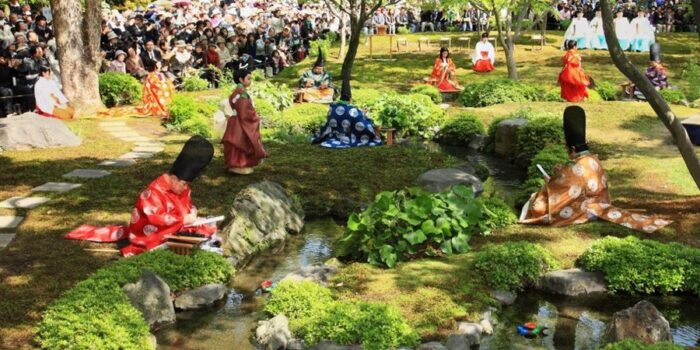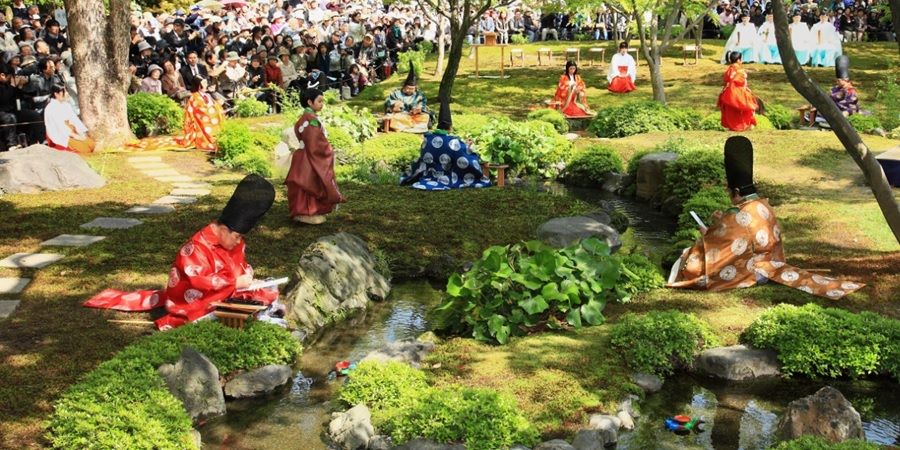The Kyokusui-no-utage ceremony in Kyoto is experiencing a revival, bringing back an ancient tradition that dates back to the Nara era.
Held at the Jōnangū Shrine, the ceremony reflects the lifestyle of Heian period nobles. Poets dressed in silk robes write waka poetry while enjoying sake, immersing themselves in the beauty and aesthetics of history.

With cultural performances like imayō dance and koto music, this event preserves Japan’s cultural heritage and allows visitors to connect with the past.
Key Takeaways
- The Kyokusui-no-utage is a traditional Japanese entertainment that originated in China and was embraced by Japan in the 5th century A.D.
- The Jōnangū Shrine in southern Kyoto is leading the revival of this ancient tradition by recreating the Kyokusui-no-utage twice a year during spring and autumn.
- The tradition reflects the lifestyle of Heian period nobles and showcases the elegance of silk robes and poetic expression.
- The Kyokusui-no-utage combines waka poetry, sake, and cultural performances, allowing for historical exploration and the preservation of Japan’s cultural heritage.
The Tradition’s History
The Kyokusui-no-utage tradition, which dates back to the Nara era and evolved during the Heian period, is a way for Japan to honor and preserve its cultural heritage. This tradition has a rich history that spans centuries.
Originating in the Nara era (710-794), it was a recreational activity enjoyed by aristocrats in the Heian period (994-1185). The Kyokusui-no-utage takes place along the Nara no Ogawa river near Kamigamo Shrine, where professional poets don Heian period costumes and write poems under designated themes.
This tradition holds great cultural significance as it allows for historical exploration through activities enjoyed by past civilizations. By showcasing Japan’s effort to preserve its cultural heritage, the Kyokusui-no-utage allows visitors to witness the beauty and aesthetics of history while connecting the present with the past.
Venue and Setting
Surrounded by lush gardens and scenic beauty, Jōnangū Shrine in southern Kyoto provides an enchanting setting for the Kyokusui-no-utage ceremony.
The shrine’s expansive gardens are divided into five sections, each reflecting different gardening styles spanning Japanese history. In spring, the gardens come alive with vibrant irises, azaleas, and wisterias, creating a picturesque backdrop for the ceremony.
The scenic surroundings enhance the overall glamour of the event, immersing visitors in the beauty of nature. The meticulously designed garden aesthetics complement the elegance of the Kyokusui-no-utage, creating a harmonious atmosphere where tradition and natural beauty intertwine.
As guests explore the verdant spaces, they can appreciate the attention to detail in every corner, from the carefully manicured plants to the tranquil streams that flow through the gardens.
The combination of the stunning scenery and the ancient ceremony makes for a truly memorable experience at Jōnangū Shrine.
Elegant Attire and Poetic Themes
Dressed in opulent silk robes, the local poets embody the elegance of the Heian period nobility during the Kyokusui-no-utage. This traditional Japanese entertainment showcases the exquisite fashion of the Heian era, known for its elaborate and colorful attire.
Inspired by the classic ‘The Tale of Genji,’ the poets compose beautiful poems that revolve around elements from this literary masterpiece. The silk robes worn by the poets reflect the grandeur and refinement of Heian fashion, with intricate patterns and rich colors.
As they recite their Genji-inspired poems, the poets exude a sense of grace and sophistication, transporting the audience back to a time of aristocratic opulence. The combination of exquisite fashion and poetic expression makes the Kyokusui-no-utage a truly enchanting experience.
Elements of the Ceremony
Poets compose waka poetry and enjoy sake during the Kyokusui-no-utage, a traditional Japanese entertainment. This event holds great cultural significance in Japan, as it showcases the rich symbolism and rituals of the Heian period.
The poets, dressed in elegant silk robes, embody the nobility of that era. The themes of their poetry are inspired by ‘The Tale of Genji,’ a classic literary masterpiece. As they write their waka poetry, they also indulge in sake, which adds to the festive atmosphere of the ceremony.
The event features the passage of small sake cups across a gentle stream, carried by bird-shaped vessels and guided by young pages using bamboo poles. Alongside the poetry and sake, there are cultural performances such as imayō dance and koto music.
The Kyokusui-no-utage is not just a celebration of poetry and sake, but a way to honor and preserve Japan’s cultural heritage through the rituals and symbolism of the Heian period.
Preserving Cultural Heritage
Jōnangū Shrine actively preserves Japan’s cultural heritage through the revival and celebration of the Kyokusui-no-utage, a traditional Japanese entertainment. This ancient tradition holds significant cultural significance and has been brought back to life through dedicated revival efforts. The shrine recreates the Kyokusui-no-utage twice a year during spring and autumn, showcasing the elegance and glamour of Heian period nobility.
To understand the beauty and essence of this tradition, let’s delve into the elements that make up the Kyokusui-no-utage ceremony. This table provides a visual representation of the various components:
| Components | Description |
|---|---|
| Waka Poetry | Poets write 31-syllable poems inspired by ‘The Tale of Genji’ |
| Sake | Sake is enjoyed by poets as they compose their verses |
| Bamboo Pole | Young pages use bamboo poles to safely transport sake cups |
| Imayō Dance Performances | Cultural performances featuring traditional dances and koto music |
Through the revival of this ancient tradition, Jōnangū Shrine is playing a vital role in preserving Japan’s cultural heritage. The Kyokusui-no-utage allows for a historical exploration, connecting the present with the past. Visitors have the opportunity to witness the beauty and aesthetics of history, immersing themselves in the rich tapestry of Japan’s cultural traditions.
Exploring Historical Significance
Visitors can explore the historical significance of the Kyokusui-no-utage through its elements, such as the waka poetry, sake, bamboo poles, and cultural performances.
The Kyokusui-no-utage tradition dates back to the Nara era and evolved during the Heian period as a recreational activity for aristocrats. It takes place along the Nara no Ogawa river near Kamigamo Shrine, showcasing Japan’s effort to preserve its cultural heritage.
Professional poets don Heian period costumes and write poems under designated themes, honoring the traditions of the past. The event combines waka poetry and sake, with poets writing 31-syllable poems while enjoying the Japanese rice wine.
Young pages ensure the safe passage of the sake cups across a gentle stream using bamboo poles.
Plus, the Kyokusui-no-utage features cultural performances such as imayō dance and koto music, further immersing visitors in the historical context and cultural preservation of Japan.
Aki Matsuri Festival
The Aki Matsuri Festival in Kyoto offers a captivating celebration of Japanese culture and traditions, featuring vibrant performances and delicious local cuisine. This annual festival is a highly anticipated event that showcases the rich heritage of Kyoto. Visitors can immerse themselves in the enchanting atmosphere as they explore the historic streets and participate in various festival attractions.
From traditional music and dance performances to colorful parades and street food stalls, there is something for everyone to enjoy. The Aki Matsuri Festival also provides a unique opportunity to experience authentic cultural experiences, such as tea ceremonies and kimono dressing. For those seeking to delve deeper into Japanese traditions, workshops and demonstrations are available, allowing visitors to learn traditional crafts and practices.
With its lively festivities and cultural treasures, the Aki Matsuri Festival in Kyoto is a must-visit for anyone seeking to fully immerse themselves in the beauty of Japanese culture.
Frequently Asked Questions
What is the significance of the date April 29th and November 3rd for the Kyokusui-no-utage ceremony?
April 29th and November 3rd hold significance for the Kyokusui-no-utage ceremony. On these dates, poets dressed in silk robes write waka poetry while sake cups are carried across a stream. The event also features cultural performances.
How are the small sake cups carried across the gentle stream during the ceremony?
During the Kyokusui-no-utage ceremony, the small sake cups are carried across the gentle stream using a unique carrying technique. The cups are placed in bird-shaped vessels that are decorated with stream-themed decorations. Skilled young pages carefully navigate the stream using bamboo poles to ensure the safe passage of the cups.
What other cultural performances are featured in the Kyokusui-no-utage ceremony besides waka poetry and sake?
Along With waka poetry and sake, the Kyokusui-no-utage ceremony features cultural performances such as traditional music. These performances, including koto music and imayō dance, add to the enchanting atmosphere of the event and showcase Japan’s rich cultural heritage.
How do the Jōnangū Shrine and Fushimi area contribute to the preservation of Japan’s cultural heritage?
Jōnangū Shrine plays a vital role in preserving Japan’s cultural heritage by reviving ancient traditions like the Kyokusui-no-utage ceremony. The Fushimi area contributes to preservation through the promotion and preservation of traditional crafts.
What are some highlights of the Aki Matsuri festival in Kyoto?
Highlights of the Aki Matsuri festival in Kyoto include captivating performances, delicious local cuisine, and the opportunity to explore the historic streets of Kyoto. Visitors can experience the rich culture and traditions of Kyoto, creating unforgettable memories in the enchanting atmosphere of Aki Matsuri.
The Sum Up
To sum it up, the Kyokusui-no-utage ceremony in Kyoto is successfully reviving an ancient tradition that was once lost to time. Thanks to the efforts of the Jōnangū Shrine, this elegant event allows visitors to step back in time and experience the beauty of the Heian period.
With its stunning gardens, silk-robed poets, and cultural performances, the ceremony truly captures the essence of Japan’s rich cultural heritage. By preserving and honoring this tradition, the Kyokusui-no-utage ceremony is not only a celebration of the past, but also an opportunity to connect with history and appreciate the aesthetics of a bygone era.




